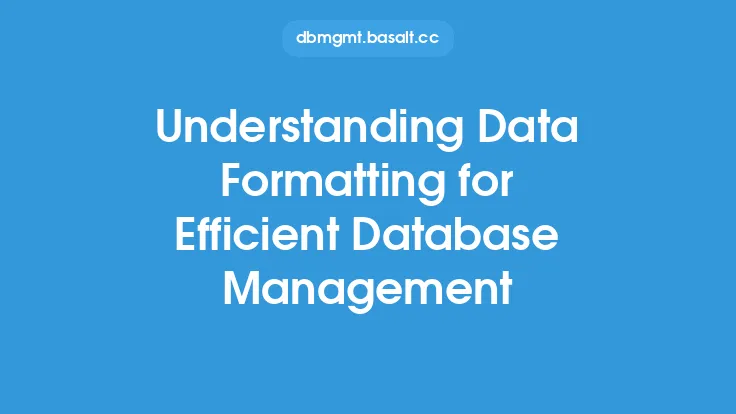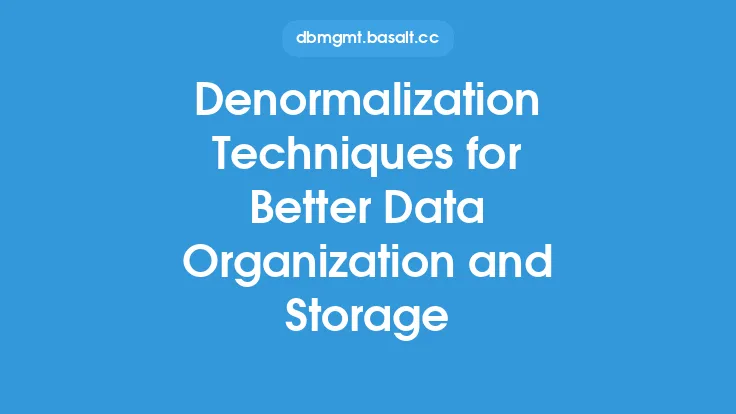Data normalization is a crucial aspect of data modeling that ensures efficient data storage and retrieval. It involves organizing data in a way that minimizes data redundancy and dependency, making it easier to maintain and scale. Normalization principles are designed to eliminate data anomalies and ensure that each piece of data is stored in one place and one place only. This approach helps to reduce data inconsistencies, improve data integrity, and enhance the overall performance of the database.
Introduction to Data Normalization
Data normalization is a multi-step process that involves applying a set of rules to a database design to ensure that it meets certain standards. The normalization process helps to eliminate data redundancy, reduce data dependency, and improve data integrity. There are several normalization rules, each with its own set of guidelines and principles. The most common normalization rules are First Normal Form (1NF), Second Normal Form (2NF), and Third Normal Form (3NF). Each rule builds on the previous one, providing a higher level of normalization and data integrity.
First Normal Form (1NF)
The First Normal Form (1NF) is the most basic level of normalization. It states that each table cell must contain a single value, and each column must contain only atomic values. In other words, each column must contain only one value, and there should be no repeating groups or arrays. To achieve 1NF, you need to eliminate repeating groups and arrays by creating separate tables for each group. For example, if you have a table that stores customer information, including their name, address, and phone numbers, you would need to create a separate table for phone numbers to eliminate the repeating group.
Second Normal Form (2NF)
The Second Normal Form (2NF) builds on the 1NF rule by eliminating partial dependencies. A partial dependency occurs when a non-key attribute depends on only one part of the primary key. To achieve 2NF, you need to create separate tables for each non-key attribute that depends on only one part of the primary key. For example, if you have a table that stores order information, including the order ID, customer ID, and order date, you would need to create a separate table for customer information to eliminate the partial dependency.
Third Normal Form (3NF)
The Third Normal Form (3NF) builds on the 2NF rule by eliminating transitive dependencies. A transitive dependency occurs when a non-key attribute depends on another non-key attribute. To achieve 3NF, you need to create separate tables for each non-key attribute that depends on another non-key attribute. For example, if you have a table that stores employee information, including their name, address, and department ID, and the department ID depends on the department name, you would need to create a separate table for department information to eliminate the transitive dependency.
Higher Normal Forms
There are several higher normal forms, including Boyce-Codd Normal Form (BCNF), Fourth Normal Form (4NF), and Fifth Normal Form (5NF). These higher normal forms provide additional rules for eliminating more complex dependencies and anomalies. However, they are less commonly used in practice, as they can be more difficult to implement and may not provide significant benefits for most databases.
Benefits of Data Normalization
Data normalization provides several benefits, including improved data integrity, reduced data redundancy, and improved scalability. By eliminating data anomalies and dependencies, normalization helps to ensure that each piece of data is stored in one place and one place only, reducing the risk of data inconsistencies and errors. Normalization also helps to improve data security by reducing the risk of data breaches and unauthorized access.
Challenges of Data Normalization
While data normalization provides several benefits, it can also present several challenges. One of the main challenges is the increased complexity of the database design, which can make it more difficult to implement and maintain. Normalization can also lead to increased join operations, which can impact database performance. Additionally, normalization can require significant changes to the database design, which can be time-consuming and costly.
Best Practices for Data Normalization
To get the most out of data normalization, it's essential to follow best practices. One of the most important best practices is to normalize the database design as much as possible, while still considering performance and scalability. It's also essential to use indexing and other optimization techniques to improve database performance. Additionally, it's crucial to document the database design and normalization rules, making it easier to maintain and modify the database over time.
Conclusion
Data normalization is a critical aspect of data modeling that ensures efficient data storage and retrieval. By applying normalization principles, you can eliminate data anomalies and dependencies, improve data integrity, and enhance the overall performance of the database. While normalization can present several challenges, following best practices and considering performance and scalability can help to minimize these challenges. By normalizing your database design, you can ensure that your data is stored in a consistent and efficient manner, making it easier to maintain and scale your database over time.





